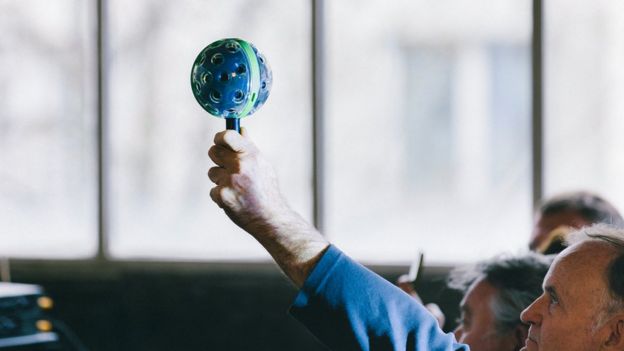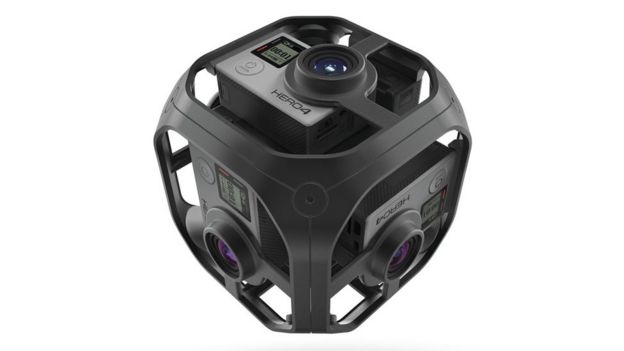The videos at 360 degrees are no longer a rarity: many of those who surf the net through mobile devices has met once with one.
But although it can bedone with any camera, for amateurs to discourage you with the complicated process of merging the images.
Luckily for those interested, however, the market could not pass up a chance like this.
And that's why in the last few years has been filling devices especially designed to facilitate this type of recordings, so that they cease to be a prerogative of the professionals.
[caption id="" align="aligncenter" width="764"]
 The market is full of 360 video cameras for non-professional use.[/caption]
The market is full of 360 video cameras for non-professional use.[/caption]But, how to choose the right product for your needs?
BBC World spoke with 2 experts to find out what there is to take into account when purchasing one of these cameras.
[anuncio_b30 id=1]
Basic aspects
The director of the production company british specialized in virtual reality View, Henry Stuart, believes that the biggest risk to the consumer is not professional is to acquire a device that is out-of-date.
"Practically, every week comes out a new device, so you have to be careful not to buy one that has already been replaced by a more modern model," he told BBC World.
And Stuart is also recommended to be done with a camera that has at least a 4k resolution, much more powerful than high definition.
[caption id="" align="aligncenter" width="898"]
 Some cameras can be attached to the cell phone like this Wink PTU.[/caption]
Some cameras can be attached to the cell phone like this Wink PTU.[/caption]The expert in virtual reality of the BBC, Stephen Beckett agreed: "With any lower resolution, the more likely it is that the video only looks good on a cell phone."
Other basic aspect to consider is the speed.
For Stuart, it should not be below the 30 frames per second.
While these are the fundamental characteristics, for Beckett also "worth" to look at the ability to record binaural sound.
"That is to say, 3D sound and a quality space. There are a few cameras for non-professionals who are already incorporating this feature," he told the BBC.
[caption id="" align="aligncenter" width="840"]
 Cameras with more lenses allow you to produce 3D videos.[/caption]
Cameras with more lenses allow you to produce 3D videos.[/caption]"A good sound helps a lot to the experience of plunging into a video, and I believe that its relevance will grow in the future," explained Beckett.
From here, it should be clear what you want the camera.
How to share trips with friends in social networks? How to immortalize feats of adventure sports?
Or maybe to enhance a business as the recording of weddings, institutional videos?
Learn how to "sew"
According to the objective, one decanted for one model or the other. But you first have to understand how to create this type of videos.
To get 360 degrees image, the devices they use more than one lens.
[caption id="" align="aligncenter" width="827"]
 The more cameras the device has, the greater the risk of images overlapping.[/caption]
The more cameras the device has, the greater the risk of images overlapping.[/caption]The most simple use two that are placed at the same height in a position back to back so that each record a different side of the scene.
So you reduce the areas where the cameras overlap , and the dots of "seam".
"Stitch" ( stitch) consists in joining in one of the images obtained by the different lenses of a camera.
"Some machines offer the user a video already sewn, so that you can save a lot of time," explained Beckett.
"But if you're going to purchase a high end computer, the more likely it is that you have to do it by yourself with tools such as Kolor Autopano," he said.
[caption id="" align="aligncenter" width="868"]
 The Ricoh Theta S is easy to use, although the resolution is not very high.[/caption]
The Ricoh Theta S is easy to use, although the resolution is not very high.[/caption]The expert of the BBC admitted that sewing is not easy and requires learning. But insisted that helps to get much better results.
"And if you want a perfect product, you will need programs of special effects such as Adobe After Effects or more complex tools like Foundry''s Nuke."
[anuncio_b30 id=1]
Intended account
For those who just want a camera to upload videos to Facebook or Instagram, Beckett recommended three options.
The first is to choose one of the devices for mobile phones as the brand Insta360.
The one that works with Android can be purchased for US$129, and designed for the iPhone,$199.
The second is the Ricoh Theta S, which sends the images to the phone via Wifi.
"The lenses are incredibly together so that you can hold it with one hand and take a picture and almost does not need stitching," added Stuart.
[caption id="" align="aligncenter" width="624"]
 The Samsung Gear 360 allows you to record videos in 360 degrees live.[/caption]
The Samsung Gear 360 allows you to record videos in 360 degrees live.[/caption]"But it is so small that the lenses and, therefore, the photos are also. So the quality is somewhat low," he said.
The third alternative is the range of Samsung Gear.
New release
The latest version, the Samsung Gear 360, was launched this year.
Allows you to get videos "very sharp and shoot with a compression that is very efficient called H. 265," according to Stuart.
It is an easy to use template that allows you to make recordings live and that the director of View recommends that "those who can't wait," and needs to be done with a camera as soon as possible.
Those who have more time, recommended to wait the few weeks that are left for the arrival of the Go Pro Fusion.
[caption id="" align="aligncenter" width="773"]
 Go Pro's Omni model has 6 cameras.[/caption]
Go Pro's Omni model has 6 cameras.[/caption]"Go Pro was one of the first brands to bring to market video cameras in 360 degrees for the general consumer," he recalled.
"It was a system called Omni, which is still important in the professional circles. It is made of 6 chambers in a cube and it is very effective," said the manager.
"But when you have a lot of time recording are overheated and this generates technical problems."
"In addition, by having 6 cameras there are 12 areas in which the cameras are overlapped, which means a large number of potential errors in the shots, "he noted.
The Go Pro Fusion, in contrast, has only two lenses and recorded to a resolution of 5.2 K.
[caption id="" align="aligncenter" width="876"]
 Go Pro Fusion is the latest release of the company and has not yet hit the market.[/caption]
Go Pro Fusion is the latest release of the company and has not yet hit the market.[/caption]An option that added Stuart is the Nikon Keymission 360, despite being and staying "a little old-fashioned" and have a low velocity, it can be submerged in the water, "so that you can make videos of great dive".
"Cameras like these don't have as much resolution or image quality as others that cost more. But even so, they are able to produce something that the consumer can enjoy with their friends," said Beckett.
"The best thing they have is their ease of use and mobility, "he added.
[anuncio_b30 id=1]
For those who want to take it a step further
For someone who wants to go a little bit further and incorporate the highest quality audio, the specialist suggested the Garmin Virb, which allows you to record spatial sound.
And for those who intend to give their creations a professional use, Beckett recommended daring to increase the number of lenses.
"This gives a higher final resolution, but it also means that there will be more data that will contribute to fix the parallax effect, that is to say, the blurring of the unions of the images of the different cameras," he explained.
[caption id="" align="aligncenter" width="891"]
 The Nikon Keymission is waterproof.[/caption]
The Nikon Keymission is waterproof.[/caption]Although he cautioned that this will increase the time dedicated to post-production.
"But most lenses also means that it will be able to make 3D video, something that makes a huge difference to the spectators," he said.
To this end, Stuart advised the Zed Cam S1, which "can be operated remotely with ease from a computer or iPad and allows you to modify the exposure, speed, white balance. all aspects of the camera that you need."
Both this and the Omni delivered to the user separate images that he must sew, an aspect to take into account before deciding on them.
Source: BBC


No comments:
Post a Comment